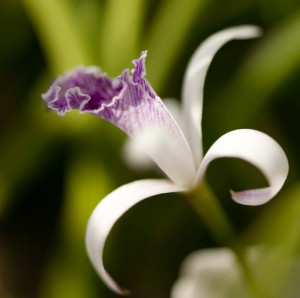Know and Grow Cattleyas: Part II
Posted in Gardening Tips on January 29 2013, by Sonia Uyterhoeven
Sonia Uyterhoeven is the NYBG‘s Gardener for Public Education.
 Orchids are typically classified as cool, intermediate, or warm growers; the designation matches the temperatures that they are accustomed to in their native habitat. Cattleyas, for their part, are intermediate to warm growers. The warm growers tend to be species that grow at low altitudes, while intermediate growers are found growing in higher altitudes. For example, the Cattleya labiata that we were discussing a few weeks ago is native to the mountain ranges in the northeastern provinces of Brazil, and is found growing at elevations above 1600 feet (500 meters).
Orchids are typically classified as cool, intermediate, or warm growers; the designation matches the temperatures that they are accustomed to in their native habitat. Cattleyas, for their part, are intermediate to warm growers. The warm growers tend to be species that grow at low altitudes, while intermediate growers are found growing in higher altitudes. For example, the Cattleya labiata that we were discussing a few weeks ago is native to the mountain ranges in the northeastern provinces of Brazil, and is found growing at elevations above 1600 feet (500 meters).
Often homeowners will look at these exotics blooms and think that they need to be pampered and require intense tropical heat. The reality is that cattleyas will do well growing in daytime temperatures ranging from 65-80° F, preferring temperatures on the cooler side of this spectrum (low 70s). Cattleyas should experience a temperature drop of 10 to 15 degrees overnight, placing nighttime temperatures in the mid to low sixties. I wouldn’t worry too much about being exact, however; modern hybrids have so many parental lineages that they generally land somewhere in the normal household temperature range. Just remember that this tropical beauty is environmentally friendly and will appreciate a home on the cooler side.
Cattleyas also prefer bright light–this means bright, filtered light in the hot summer months and full light in the winter. The leaves have a thick, waxy coating that helps protect them against burn from direct sunlight. Cattleyas further like the humidity to be around 50%, which can pose a challenge for homeowners. Investing in a humidifier or creating a pebble tray that holds water and releases it into the atmosphere is an excellent option. Otherwise, keep orchids away from heat sources–they may be able to handle the temperatures, but they will certainly not appreciate the dry air. Clustering plants together and placing them in the kitchen or bathroom where humidity is higher will help.
 The growth cycle of the cattleya depends on the species and, for the homeowner, it is important to observe your orchid and treat it accordingly. The orchid we discussed the other week, Cattleya labiata, flowers from September into November. After flowering, it requires a resting period where you cut back on the watering and fertilizer until it resumes growth in late winter. Increase watering and fertilizer once it starts to grow and produce new pseudobulbs. The plant may produce two separate growth cycles, one in late winter or early spring, and one in late spring or summer; both will flower in the fall.
The growth cycle of the cattleya depends on the species and, for the homeowner, it is important to observe your orchid and treat it accordingly. The orchid we discussed the other week, Cattleya labiata, flowers from September into November. After flowering, it requires a resting period where you cut back on the watering and fertilizer until it resumes growth in late winter. Increase watering and fertilizer once it starts to grow and produce new pseudobulbs. The plant may produce two separate growth cycles, one in late winter or early spring, and one in late spring or summer; both will flower in the fall.
Other cattleyas flower in the spring. Sometimes they flower, produce the new growth immediately, and then rest in the late fall to winter. In this case, you would fertilize and water throughout the growing season, and reduce water and fertilizer in the winter resting months. Some cattleyas wait until the pseudobulb is mature before they flower, while others flower as the pseudobulb is still developing.
Many of the complex hybrids, on the other hand, never seem to rest. They flower, start producing new growth, and then flower again. The amount of water and fertilizer will stay fairly consistent in this case–just watch for the changing light levels of the seasons in your home. Things naturally start to slow down in low-light winters, and it often makes sense to adjust watering and fertilizing accordingly. This gets tricky when the heating goes on in the winter, creating a situation with high temperature and low humidity. Keep an eye on watering so things don’t dry out.
The new growth on a cattleya comes from the base of the existing pseudobulbs. It looks like little eyes or pointed tips when it first emerges. Once the new growth starts on the pseudobulbs, root growth follows, making it a good time to place the orchid in a new home. It is also a good time to clean up your plant and remove any old or unwanted pseudobulbs. Cattleyas should be repotted every two to three years in a fresh mix, preferably a free-draining mix made of fir bark chips, charcoal and perlite, but many products will suffice. As far as containers go, terra cotta pots work best, since they provide stability and good aeration for the root system. In a warm household where drying out is a challenge, plastic pots that retain moisture may work better.
 The flower spikes form underneath a protective green sheath that covers the pseudobulb. The sheath splits open, the orchid flowers, and the sheath eventually dries out. Many orchid growers scrape off the papery brown sheath once flowering is completed. In the home environment, typical pest problems include mealy bugs and scale, which often hide under the dried sheath. To remove it, take an old tooth brush and gently rub it off. Scale and mealy bugs can be treated with a diluted solution of Murphy’s® oil soap–two tablespoons to a quart of lukewarm water. Spray it on, let it sit for 20 minutes, then rinse it off.
The flower spikes form underneath a protective green sheath that covers the pseudobulb. The sheath splits open, the orchid flowers, and the sheath eventually dries out. Many orchid growers scrape off the papery brown sheath once flowering is completed. In the home environment, typical pest problems include mealy bugs and scale, which often hide under the dried sheath. To remove it, take an old tooth brush and gently rub it off. Scale and mealy bugs can be treated with a diluted solution of Murphy’s® oil soap–two tablespoons to a quart of lukewarm water. Spray it on, let it sit for 20 minutes, then rinse it off.
Aside from these minor issues, you will find that your cattleya orchids are essentially trouble free. If the temperature in your home stays too warm, it will grow but may not flower. Cattleyas do well with neglect–overwatering can cause a great deal of damage–so when in doubt, just walk away from the plant.
If you are yearning for some tropical magic in your life, we will have plenty of orchids for sale at our annual Orchid Show, which runs from March 3 through April 21. For entertainment this year we will be featuring music from all over the globe, including bands from Brazil, Cuba, Peru, Africa, India, and the U.S. Visit our website and plan your visit to include some of your favorite music.


thanks so much for the information about tending to Cattleyas. All the details you provide are inspiring. Love the complete and methodical way you cover botanical topics. I’m counting the seconds until the Orchid Show.